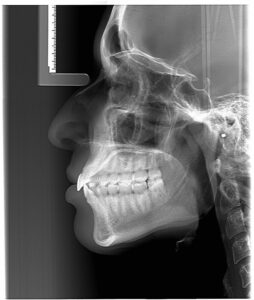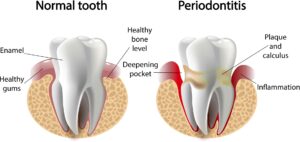Header logo
header top contact widget
Asheville Periodontist
As You Age, Avoid A ‘Melting’ Face With Dental Implants
Posted on Feb 26, 2024 by William J. Claiborne, DDS MS
It seems the older one gets, the more conscious he or she is to the need for good health practices. While periodic exams and check-ups are part of this, eating healthy and getting ample exercise are practical ways to support a healthy body.
The same principles apply to oral health. While annual physical exams are needed, regular check ups and dental hygiene cleanings are as well. Through decades of research, “bad” bacteria in the mouth can lead to inflammatory reactions that can offset or worsen a number of health problems far beyond the mouth.
For now, let’s focus on your gum health and the presence of teeth. While natural teeth are the ideal structure for biting, chewing and speaking, the rigors of age – the natural wear and tear – can take its toll on teeth. Decay, gum disease, accidents and certain illnesses can lead to losing a tooth or teeth over the span of a lifetime.
There are several ways to replace a missing tooth (or teeth). A crown-&-bridge is a longstanding method to replace one or several teeth in one area. Or, a partial denture can replace a “scattering” of teeth in the same arch. However, the downside of these oral prosthetics is what’s beneath the gum line.
Your natural teeth are supported by your upper and lower jaw bone, known respectfully as the maxilla and mandible. With these strong, study bones, tooth roots are held securely. Thus, biting and chewing occurs comfortably.
The jaw bones are actually kept healthy by the presence of tooth roots. These roots provide stimulation to the bone as well as nourishment that feeds through the tooth’s interior.
When a tooth is removed, so is the stimulation and nourishment to that area of the jaw bone. Without it, the bone begins to shrink. As it declines in height, the adjacent teeth are more vulnerable to loss. Statistics show that teeth adjacent to areas where natural teeth are missing will be the most likely to be lost next.
This has a domino effect. Partials can replace the presence of teeth above the gum line, but there is nothing to benefit the jaw bones below. Thus, tooth loss continues and can go from a few missing teeth to losing all teeth (being “edentulous”).
According to the Center for Disease Control & Prevention (CDC), 69 percent of adults between the ages of 35 – 44 have lost at least one permanent tooth. By age 50, Americans are missing an average of 12 teeth. For adults between the ages of 65 – 74, 26 percent are missing all of their natural teeth. That’s over one-fourth of the adult population over age 65.
Although dentures and partials mimic the presence of teeth, the jaw bones below are shrinking away, and at a rather rapid pace. The pressure of wearing a denture or partial actually speeds this process up, known as “resorption.”
As these bones decline in mass, deep wrinkles form around the mouth. The corners of the mouth turn downward. The chin takes on a more pointed form and the mouth sinks into the face. The nose seems to get closer to the chin as the jaw bones thin. Jowls form as facial muscles detach from shrinking bone structure.
Changes in facial appearance also take place when bone structures shrink. For example, as the jaw bone thins, deep wrinkles form around the mouth. The corners of the mouth will start to turn down, even in a smile. Jowls form on each side of the face as facial muscles detach from the shrinking bone structure.
As the jaw bone declines further, the chin becomes more pointed and the nose seems to get closer to it. This leads to a collapsed mouth that is known as a “granny look.” This look ages the appearance of an individual far beyond their actual years.
Not to be overlooked is the ability to comfortably bite and chew food. This is essential for the digestive process, since the first stage of digestion begins in the mouth. When adults struggle to eat with a denture or partial, the efficiency of this initial stage of digestion is compromised.
It’s not unusual for adults who have “rocky” or “slippery” dentures to opt for soft foods that dissolve easily in the mouth. These are often carb heavy and lack the nutritional value of a diet that combines healthy proteins, fruits and vegetables.
However, missing teeth or dentures that move when eating can cause other detrimental problems. When people sense their dentures may cause embarrassment when eating, speaking or laughing with others, social involvement can take a hit. According to a 2012 statement by the World Health Organization:
“Oral health is essential to general health and quality of life. It is a state of being free from mouth and facial pain, oral and throat cancer, oral infection and sores, periodontal (gum) disease, tooth decay, tooth loss, and other diseases and disorders that limit an individual’s capacity in biting, chewing, smiling, speaking, and psycho-social well-being.”
As an Asheville periodontist, my dental specialty includes the diagnosis and placement of dental implants. Dental implants are the closest thing to natural teeth.
Dental implants were designed to recreate the presence of natural teeth both above and below the gum line. Because teeth attached to the implants are supported by the jaw bone, the study foundation restores the ability to bite and chew without movement or fear of embarrassing slips.
For patients who are missing a great deal of bone, we offer bone rebuilding that does not require a bone graft. We also perform sinus lifts (when the upper jaw has declined to a significant level) to restore sufficient bone distance between vital structures.
For many of our dental implant patients, their lives become more active with the restored confidence. They become more socially involved, have more self-confidence and higher self-esteem. And the advantages of dental implants over other tooth replacement options are numerous.
• Dental implants are designed to last your lifetime. They do not decay, need root canals or compromise neighboring teeth or bone structure.
• Because dental implants are positioned in the jaw, they recreate stimulation to the bone. This helps to preserve the bone’s mass, halting the pace of jaw bone shrinkage (known as resorption).
• Resorption is what causes changes in one’s facial appearance, aging one’s appearance far older than their actual age.
• Dental implants do not move or slip when eating, speaking or laughing. A denture is designed to fit the contours of one’s gum ridge; contours that exist at the time the denture is made. However, as resorption reduces bone height, the ridge that holds the denture flattens out over time. This is why a denture becomes ‘wobbly’ or ‘slippery.’
• Dental implant treatment is largely determined by the number of implants placed. In most cases, one implant can support more than one tooth. A full arch (all upper or lower) of teeth are typically supported by several strategically-placed implants.
• Unlike a crown-&-bridge, dental implants so not need the support of adjacent teeth. Therefore, it is not necessary to have teeth shaved down for crowning simply to serve as supports for a bridge.
In our Asheville periodontal dental office, we have highly-advanced technology that aids in the diagnosis and placement process of dental implants. These features help to enhance patient comfort, shorten treatment time, and provide optimal results. Advanced technology includes:
– Computerized Dental Implant Placement – an advanced system for pre-surgical positioning of dental implants using a 3D model of the patient’s jaw. Once the implant type is selected, a template is developed for optimal treatment success.
– Cone Beam Imaging – is ideal for diagnoses and treatment planning through images that provide a clear view of the upper and lower jaw (including nerve canals), with rotations that show sagittal, axial, and coronal planes in a process that is quick, painless and at minimal radiation levels.
– Dental Laser – This small, hand-held device is a tremendous asset when it comes to both the health and appearance of gum tissues. Not only does the laser eliminate or greatly minimize bleeding during procedures, it reduces numbing requirements, removes bacteria and easily uncovers gum tissue where dental implants have been placed. Additionally, laser dentistry can beautifully re-contour or repair gum tissue with a precision line.
As a periodontal specialist serving Western NC, I take great pride in the diagnosis and placement of dental implants with each selected based upon the patient’s individual needs and goals. We provide oral or I.V. sedation to ensure a comfortable experience and a friendly, respectful environment.
To schedule an examination appointment or to begin with a consultation, call 828-274-9440. A referral is not always necessary.
Dental Fear Can Be Detrimental To More Than Your Smile
Posted on Feb 15, 2024 by William J. Claiborne, DDS MS
There are varying figures on the prevalence of dental fear in the U.S. However, there is no argument that it exists and affects a rather substantial number of adults.
A 2018 study shared by Dental Products Report listed the results of a study of things that keep adults from going to the dentist. Over 60% of the 18,000 polled admitted to having dental fear. Four percent shared they had never gone to a dentist as a result.
https://www.dentalproductsreport.com/view/study-finds-more-60-percent-people-suffer-dental-fear
Another study by the Cleveland Clinic stated that about 36% of people in the U.S. have a fear of dental treatment, with 12% having an extreme fear (known as “dental phobia”).
While traumatic experiences in the past (often as a child) cause some people to be fearful of dental visits, others are not aware of why or how their fears began.
The Cleveland Clinic cites the top reasons that cause people to avoid or delay dental care are:
• Fear that the anesthetic won’t be sufficient or fear of the side effects (such as numb lips) after treatment
• Fear of bleeding during a dental procedure
• Fear gagging, choking or not being able to breathe or swallow during treatment
• Fear of dentist (often due to a bad experience in the past)
• Fear of pain
• Fear of needles
• The noise made by drills or other instruments used by the dentist or hygienist
• The smells of antiseptics or other chemicals used in a dental office
https://my.clevelandclinic.org/health/diseases/22594-dentophobia-fear-of-dentists
Having the jitters at the dental office is not all that difficult to understand. During these visits, patients are positioned on their backs on a narrow recliner with a bright light shining in their faces. Add to that having to maintain an open mouth (which is full of sensitive nerves) without really knowing what is being done. It’s not surprising that there are some uneasy feelings.
Fear or anxiety are normal reactions of the brain’s “fight or flight” response. For instance, some people have an intense fear of spiders or heights. Their reactions are automatic. Yet, in many cases of dental fear, some learn to override these reactions once they develop a sense of trust in being treated gently and respectfully.
In addition to avoiding care due to fear, some of the oral health problems we see occur from:
– Insufficient oral hygiene
– Avoiding regular dental check-ups and cleanings
– Ignoring symptoms of gum disease, such as seeing blood in the sink when brushing
– Brushing too rigorously or using abrasive substances to brush
– Age-related problems, such as oral dryness
– Oral dryness due to snoring or sinus problems
– Eating a high-carb diet or snacking frequently
– Smoking (including cigarettes, vaping, marijuana, and chew)
– Regular alcohol consumption
Certainly, some people are merely more susceptible to dental decay and bacterial buildup in the mouth. It can be due to genetics or some illnesses and diseases. Yet, the majority of reasons for having oral problems can be dealt with through proper at-home care and having regular dental exams.
When dental care is delayed or avoided due to fear, small problems that could have been prevented (or easily resolved) become big problems. Big problems require more extensive procedures, more expense and more time in treatment. When dental needs become more significant, fearful patients are actually adding to their reasons to dread the dentist.
Too, when regular dental check-ups and cleanings are avoided, the result can lead to periodontal (gum) disease, which is the nation’s leading cause of adult tooth loss. Periodontal disease occurs when an over-accumulation of oral bacteria become infectious. As it penetrates gum tissues, it also attacks the bone structures underneath the gums. This disease requires treatment that is more extensive.
Additionally, tooth loss can create an entirely new set of procedural needs and costs.
For the individual who has high anxiety or fear associated with dental visits, how are they supposed to set aside these obstacles in order to receive the dental care they need? Obviously, problems in the mouth can easily exacerbate when the signs and symptoms of gum disease are back-burnered.
At our Asheville periodontal dental office, we believe that an informed patient is a healthier patient. Understanding what the problems are and what we are doing to attend to them often helps to keep the patient involved with their oral health. It also tends to help the patient relax.
As a periodontist, I feel it’s important for every adult to know the signs and symptoms of gum disease:
Gums that bleed easily
Red, swollen, tender gums
Persistent bad breath
Gums that pull away from the teeth (recede)
Changes in the way teeth fit together when biting
Changes in the fit of partial dentures
Permanent teeth that loosen or separate
When any of these emerge, prompt treatment can minimize treatment time and costs. However, ignoring the warning signs merely allows the disease to progress further – requiring more time in treatment and greater expense.
In addition to the related problems of cavities, bad breath and tooth loss, the inflammatory bacteria of gum disease can impact overall health. Years of studies have found frightening correlations between oral bacteria and the worsening or development of serious diseases.
Research has found that the oral bacteria of gum disease (which affects over 47% of the nation’s adult population) can enter the bloodstream. Once bloodborne, this bacteria has been found to trigger inflammation that has been associated with a wide range of serious health problems. Research has shown links between these infectious bacteria to heart disease, stroke, diabetes, arthritis, some cancers, preterm babies, erectile dysfunction (ED) and even Alzheimer’s disease.
I am very proud of the relationship of trust my team and I have with our patients. They know our goal is to never cause them discomfort. Although we cannot always guarantee they’ll have no discomfort at all, we take extra steps to provide optimal comfort at every visit.
In addition to this commitment, we offer oral sedation and I.V. sedation (also referred to as “twilight sleep”).
Oral sedation is a pill that helps patients relax. It also has an amnesiac effect, leaving most with little or no memory of treatment afterward. I.V. sedation places the patient in a deeper sleep state, also erasing memory of the procedure. It is administered by a doctor of anesthesiology, overseen by Dr. Brad Stone, a Medical Doctor (MD) and a board certified Anesthesiologist & Pediatric Anesthesiologist.
https://www.biltmoreperiodontics.com/comprehensive-care-team/
With both sedation options, patients are closely monitored with advanced safety equipment throughout treatment.
If fear has prevented you from a healthy smile, schedule a consultation in our Western NC periodontal dental office. During this time, we can discuss comfort options that may be best for your individual needs. Call 828-274-9440.
Do Different Age Groups Perceive the Importance of Oral Health Differently?
Posted on Feb 09, 2024 by William J. Claiborne, DDS MS
Just how important is your oral health?
Although Americans often focus on their smiles esthetically, it’s a far more important part of you than is often given due credit on a day-to-day basis. Yes, straight, white teeth help to enhance the appearance of a smile (as well as facial appearance), it’s what is typically not seen that has far greater importance.
About 50% of the world’s population over the age of 30 suffer from periodontitis. In the U.S., a developed country with excellent healthcare, a whopping 47% of adults over the age of 30 have some level of periodontal disease.
Because gum disease can begin without obvious symptoms, or be present without having pain, it is too easily ignored. This allows the disease to progress further.
The early stage, known as gingivitis, usually begins with swollen and tender gums that bleed easily when brushing teeth. As it worsens, the healthy pink hue of gums darken to more of a red color and breath odor is persistently bad. The gums begin to loosen their strong grip around the base of teeth, allowing infectious bacteria to reach bone structures that support tooth roots. In advanced stages (periodontitis), pus pockets form near the base of some teeth and gums become spongy in texture.
The bacteria of periodontal disease doesn’t just damage oral health. Through weakened oral tissues, the bacteria can enter the bloodstream and trigger inflammatory reactions. These reactions can worsen some serious health conditions and even activate others.
Research has found correlations between these bacteria and heart disease, stroke, diabetes, arthritis, some cancers (including pancreatic), preterm babies, erectile dysfunction, and Alzheimer’s disease.
In a 2020 study, individuals with gum disease who contracted COVID-19 were 9 times more likely to die. And, the study showed that COVID patients who already had advanced gum disease were 3 times more likely to end up in intensive care or on a ventilator. Evidence shows that poor oral health can increase viral infection severity, and even fatality rates.
But, does age play a part in the commitment to oral health?
A report commissioned by Delta Dental Plans Association revealed some concerning information regarding age groups and perceptions of oral health. With over 1,000 online participants, 87% listed their priority for maintaining proper oral care was to save money or avoid unexpected expenses. Two-thirds of the group listed their commitment to at-home dental hygiene as the desire to avoid tooth decay and gum disease. Yet, only 79% of adults stated they brushed their teeth twice a day with only 33% admitting to flossing daily.
In reviewing age groups, the report found that baby boomers (those born between 1946 – 1964) understand there is a strong link between their oral and overall health, but are less aware than other generations about the connection between poor dental health and chronic diseases (such as arthritis and diabetes). Those listed in the Generation Z group (born between 1997 – 2012) showed less commitment to their oral health as the “boomers,” but are more focused on eco-friendly and nontraditional oral care products. Only 76% of Generation Z agreed that oral health is closely connected to overall health.
An article in RDH Today recently shared that one-third of millennials (born between 1981 and 1996) admit to only brushing once per day, and the average millennial has gone over two days without brushing at all. Yet, 28% of young adults admit that ““The appearance of my mouth and teeth affects my ability to interview for a job.”
The study also shared that 27% of millennials are uncomfortable going to the dentist compared to 23% of respondents 55 years and older, and 56% of millennials have simply made an excuse not to go to the dentist compared to the 36% of those 55 years and older.
While fear remains a factor in a percentage of adults, this deterrent has existed for years among all ages. The American Dental Association conducted a survey on millennials, the fear issue was not the leading problem. Cost and inconvenient time and location were cited as the top excuses for avoiding regular dental care.
Excuses aside, here are some reminders about the benefits of maintaining good oral health:
• Technology – Today’s imaging technology (such as our Cone Beam technology and IntraOral scanners), allow us to treatment plan for the most conservative treatment possible. These amazing features provide amazing detail so treatment can be performed with precision for optimal outcomes.
• Comfort – In addition to the conservative treatment made possible by advanced imaging technology, we offer enhanced comfort options, including oral and I.V. sedation. Also referred to as “twilight sleep” or “sleep dentistry,” these sedatives are administered by a doctor of anesthesia who utilizes advanced safety monitoring equipment.
• Savings of Time & Money – The reason for 6-month dental check-ups and dental cleanings is to remove tartar buildup before damage can occur. Your hygienist and dentist can look for signs of gum disease so measures can be taken before the disease explodes into the need for more costly treatment to resolve the problem. Since gum disease is the nation’s leading cause of adult tooth loss, the associated expenses of replacing teeth can also be avoided by maintaining good oral health.
• Bolstering Overall Health – Although the Covid pandemic made us more aware of the benefits of vaccines and healthy habits such as hand-washing, it is our immune system that makes people more or less vulnerable. By investing in having healthy gums, the immune system is supported.
Be aware of the signs and symptoms of gum disease. These include:
Sore, swollen gums
Gums that bleed easily when brushing
Persistent bad breath
Gums that recede (pull away or loosen from the base of teeth)
Gums that turn red in color
Pus pockets that form at the base of some teeth
Teeth that loosen or shift
If you have any of these, you are urged to seek periodontal care as soon as possible. This disease will only worsen without treatment.
Call 828-274-9440 to schedule a consultation in our state-of-the-art Asheville periodontal dental office. A referral is not required.
Sources:
https://onlinelibrary.wiley.com/doi/10.1111/jcpe.13435https://www.cdc.gov/nchs/fastats/dental.htm
https://www.todaysrdh.com/do-millennials-truly-have-worse-oral-health-than-their-parents/
https://nypost.com/2018/02/23/millennials-are-terrible-at-keeping-their-teeth-clean/
Gum Disease, Tooth Loss Warnings For Smokers
Posted on Jan 29, 2024 by William J. Claiborne, DDS MS
We’re a month in to the new year. If you made the resolution to quit smoking, you may be struggling at this point. But keep up the effort. In addition to the many problems associated with smoking, your smile is also at risk.
As a periodontist in Asheville, NC, I’ve seen how significantly the habit of cigarette smoking can have on one’s smile. It’s no secret that smoking cigarettes can stain teeth and cause bad breath. However, nicotine in any form is a hazardous force in the mouth.
In studies, smokers were 3 – 6 times more likely to have gum disease than nonsmokers. One reason is because smoking is very drying to oral tissues and decreases saliva production. Less saliva means there is less of a natural ‘rinsing’ away of bacteria in the mouth. This leads to higher concentrations of oral bacteria.
Dry tissues also slows healing in the mouth. The longer it takes for tissues to heal, the greater the potential for bacterial complications.
In one study, it was found that smokers were twice as likely as non-smokers to lose teeth in the five years after completing treatment for gum disease. Smokers are also shown to respond less favorably to oral surgery treatments due to slowed healing. For the same reason, dental implants are more likely to fail in smokers.
Researchers who have studied the effects of tobacco smoke on oral tissues say it appears to interfere with the body’s natural ability to fight disease and promote healing. Apparently, smoking affects the way gum tissue responds to all types of treatment, possibly due to tobacco chemicals that interfere with blood flow to the gums. This slows the healing process and makes treatment results less favorable.
According to a study at Temple University, pipe and cigar smokers and users of smokeless tobacco (“chew”) are just as prone to implant complications than cigarette smokers. The study showed three times the amount of moderate to severe gum disease as that of non-smokers.
The American Dental Association (ADA) also warns that smoking can cause the gums to recede from teeth, exposing vulnerable tooth root sections. This enables easier entry of oral bacteria into the structures that support tooth roots. Smoking can also delay healing following periodontal therapy, extractions or implant placement. The longer it takes oral tissues to heal, the greater the risks for infection to develop.
Additionally, smoking increases the risks of oral cancer, lesions inside the mouth, periodontal (gum) disease, enamel erosion and tooth loss. It greatly reduces saliva flow in the mouth, which is a tremendous aid in removing bacteria and food particles from the mouth, helping to control bacteria levels. The condition of “dry mouth” also causes bad breath.
According to the Centers for Disease Control & Prevention (CDC), a smoker has twice the risk for gum disease compared with that of a nonsmoker. (https://www.cdc.gov/tobacco/campaign/tips/diseases/periodontal-gum-disease.html)
When a patient is diagnosed with advanced periodontal disease (periodontitis), they must make a commitment of time and expense to rid this inflammatory disease from their mouths. For those who ignore its presence or assume it will get better on its own, the disease will simply progress further.
Gum disease begins with sore gums that may bleed while brushing teeth. Or, it may cause no noticeable symptoms at all in early stages.
As it worsens, gum disease will cause frequent bad breath, tender gums that turn red, gum recession, and gums that bleed easily when brushing. Pus pockets may form on the gums. As it attacks the structures beneath the gum line, teeth may loosen or shift.
As the nation’s leading cause of adult tooth loss, it brings the hard decisions (and expense) for replacement. After all, you need teeth for eating and speaking. Do you go with dental implants? Or, do you take on the challenges that come with dentures and partials? As hard as the decisions of replacing teeth can be, gum disease can bring even more devastation with it.
Research has linked the bacteria of gum disease to serious health problems. These include heart disease, stroke, preterm babies, arthritis, diabetes, impotency, some cancers and even Alzheimer’s disease. These connections occur through the infectious bacteria of gum disease entering the bloodstream through tears in diseased gum tissues.According to the Centers for Disease Control & Prevention (CDC), a smoker has twice the risk for gum disease compared with that of a nonsmoker.
(https://www.cdc.gov/tobacco/campaign/tips/diseases/periodontal-gum-disease.html)
When a patient is diagnosed with advanced periodontal disease (periodontitis), they must make a commitment of time and expense to rid this inflammatory disease from their mouths. For those who ignore its presence or assume it will get better on its own, the disease will simply progress further.
Gum disease begins with sore gums that may bleed while brushing teeth. Or, it may cause no noticeable symptoms at all in early stages.
As it worsens, gum disease will cause frequent bad breath, tender gums that turn red, gum recession, and gums that bleed easily when brushing. Pus pockets may form on the gums. As it attacks the structures beneath the gum line, teeth may loosen or shift.
As the nation’s leading cause of adult tooth loss, it brings the hard decisions (and expense) for replacement. After all, you need teeth for eating and speaking. Do you go with dental implants? Or, do you take on the challenges that come with dentures and partials? As hard as the decisions of replacing teeth can be, gum disease can bring even more devastation with it.
Research has linked the bacteria of gum disease to serious health problems. These include heart disease, stroke, preterm babies, arthritis, diabetes, impotency, some cancers and even Alzheimer’s disease. These connections occur through the infectious bacteria of gum disease entering the bloodstream through tears in diseased gum tissues.
If you feel your smile is safe by switching to vaping (use of e-cigarettes), read on.
Because of the vape’s moist presence in the mouth, the assumption with vaping over smoking cigarettes is the “benefit” of oral dryness. However, this is easily dispelled when looking at the true facts.

While there are more than 7,000 chemicals found in the smoke of tobacco products, (including nicotine, tar, carbon monoxide, acetaldehyde and N-nitrosamines), nicotine is the primary addicting component. A study of some e-cigarette products found the vapor contains known carcinogens and toxic chemicals, as well as potentially toxic metal particles from the device itself.
The e-liquids delivered by these devices typically contain nicotine, propylene or polyethylene glycol, glycerin, and additives.
In addition to the treatment of all stages of periodontal disease, a periodontist is highly skilled in dental implant placement. Dental implants have become a leading choice in tooth replacement for many reasons, including:
• Dental implants restore one’s natural ability to bite and chew comfortably.
• Dental implants allow people to eat a healthy diet of foods, chewing thoroughly to support good digestion.
• Dental implants enhance confidence when speaking, laughing and dining in social gatherings.
• Dental implants recreate stimulation to the jaw bone like that of natural tooth roots, which helps to halt bone loss.
• Through the prevention of further bone loss, dental implants contribute to the well-big of neighboring teeth
• Dental implants slow the aging changes to facial appearance by preserving jaw bone mass.
• Dental implants, with properly maintenance, are designed to last a lifetime.
One of the most appealing aspects is the longevity of dental implants. Today’s implants are designed to last a lifetime with up to a 98 percent success rate. This is one of the highest success rates for any implant-in-bone procedure.
However, like anything that’s not a natural part of the body, there is a potential for failure. For smokers, the habit is a significant contributor to implant failure.
Studies have shown that people who smoke have more calculus (also known as tartar) than nonsmokers. Calculus is the cement-like buildup on teeth, which is a concentrated mass of oral bacteria. When gums are weakened by an over-accumulation of bacteria, successful integration of dental implants is compromised.
Having a successful outcome with dental implant treatment is worth the efforts to quit smoking. Within two weeks of quitting, gum health improves. (https://www.cancer.gov/about-cancer/causes-prevention/risk/tobacco/cessation-fact-sheet)
In our Western NC periodontal dental office, we intend for every dental implant we place to provide a successful outcome. However, patients who smoke must understand they have higher risks for complications, and even failure of dental implants. The first step is a thorough evaluation of your gums and the existing bone to support dental implants.
At your initial visit, I’ll answer your questions about the process, anticipated costs, and even sedation options. Call 586-739-2155 for an exam appointment or consultation or tap here to begin.
Recent Posts
Categories
Archives
- September 2024
- August 2024
- July 2024
- June 2024
- May 2024
- April 2024
- March 2024
- February 2024
- January 2024
- December 2023
- November 2023
- October 2023
- September 2023
- August 2023
- July 2023
- June 2023
- May 2023
- April 2023
- March 2023
- February 2023
- January 2023
- December 2022
- November 2022
- October 2022
- September 2022
- August 2022
- July 2022
- June 2022
- May 2022
- April 2022
- March 2022
- February 2022
- January 2022
- December 2021
- November 2021
- October 2021
- September 2021
- August 2021
- July 2021
- June 2021
- May 2021
- April 2021
- March 2021
- February 2021
- January 2021
- December 2020
- November 2020
- October 2020
- September 2020
- August 2020
- July 2020
- June 2020
- May 2020
- April 2020
- March 2020
- February 2020
- January 2020
- December 2019
- November 2019
- October 2019
- September 2019
- August 2019
- July 2019
- June 2019
- May 2019
- April 2019
- March 2019
- February 2019
- January 2019
- December 2018
- November 2018
- October 2018
- September 2018
- August 2018
- July 2018
- June 2018
- May 2018
- April 2018
- March 2018
- February 2018
- January 2018
- December 2017
- November 2017
- October 2017
- September 2017
- August 2017
- July 2017
- June 2017
- May 2017
- April 2017
- March 2017
- February 2017
- January 2017
- December 2016
- November 2016
- October 2016
- September 2016
- August 2016
- July 2016
- June 2016
- May 2016
- April 2016
- March 2016
- February 2016
- January 2016
- December 2015
- November 2015
- October 2015
- September 2015
- August 2015
- July 2015
- June 2015
- May 2015
- April 2015
- March 2015
- February 2015
- January 2015
- December 2014
- November 2014
- October 2014
- September 2014
- August 2014
- July 2014
- June 2014
- May 2014
- April 2014
- March 2014
- February 2014
- January 2014
- December 2013
- November 2013
- October 2013
- September 2013
- August 2013
- July 2013
- June 2013
- May 2013
- April 2013
- March 2013
- February 2013
- January 2013
- December 2012
- November 2012
- October 2012
- September 2012
- August 2012
- July 2012
- June 2012


